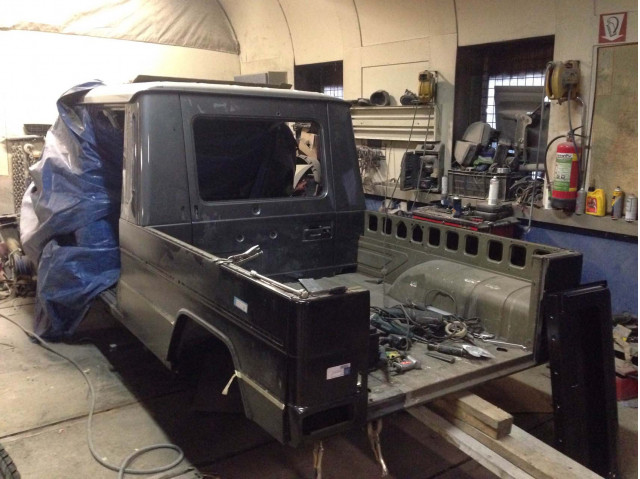Off-roader built a Mercedes-Benz G-Class pickup because Mercedes won't for the US
Mani Kulasooriya just wanted to build a capable off-road truck that wasn’t too flamboyant.
He failed miserably.
His one-of-a-kind 2006 Mercedes-Benz G500 pickup truck can’t turn a wheel without drawing a crowd, whether it’s off road in a forest full of redwoods or picking up groceries.
The project began in 2011. Mani, a tech entrepreneur from Woodside, California, was ready to tackle something different after restoring an MG Midget and a Triumph TR2. An avid mountain biker, Mani’s goal was to be able to lug five mountain bikes into the wilderness. Originally, the plan called for a Land Rover Defender 110, but then Mercedes-AMG caught Mani’s attention with the debut of its shining star, the G63 6x6.
Mani called the G63 6x6 AMG an “amazing piece of engineering,” but, "how do you pay that price and take it off-road?” Mani told Motor Authority.
The solution was simple: buy a used G-Class and turn it into his idea of an off-road pickup truck.

Mani Kulasooriya's Mercedes-Benz G-Class pickup truck

Mani Kulasooriya's Mercedes-Benz G-Class pickup truck

Mani Kulasooriya's Mercedes-Benz G-Class pickup truck
Things would have been easier if Mani had lived outside the U.S., as Mercedes-Benz makes a G-Class pickup truck for other markets, though it’s not nearly as luxurious inside or as off-road capable as the truck Mani had in mind.
A hard-target search uncovered a donor 2006 Mercedes-Benz G500 that Mani purchased in late 2013. The next step was to head off to the Netherlands, where several companies do G-Wagen conversions.
Why not the new (at the time) G63 or the previous G55? The G63 was too expensive and hard to find used, while the stock G500 had better off-road capabilities, according to Mani. Wheels and tires also played a factor. Mani wanted a bead-lock tire-and-wheel combo, but sourcing such a setup for the AMG models became cost prohibitive.
At the cost of about $5,000, Mani shipped the G500 to Albert Bouma at Ikwileeng in the Netherlands to begin the conversion.
The issues began immediately.
Ironically, it wasn’t the build that caused the issues. As a non-EU vehicle, Mani had to pay taxes to import the G500 to the Netherlands. That was a headache.
Then, the G500 sat at port for a month as Mani arranged for the taxes to be paid with a bond that he could get back as long as the truck left the EU within a year.

Mani Kulasooriya's Mercedes-Benz G-Class pickup truck

Mani Kulasooriya's Mercedes-Benz G-Class pickup truck

Mani Kulasooriya's Mercedes-Benz G-Class pickup truck

Mani Kulasooriya's Mercedes-Benz G-Class pickup truck
Lego-like conversion
The conversion itself wasn’t that hard. “It’s like Legos,” Mani said. “You can tear it apart and put it back together quite easy.”
Removing the body from the frame allowed Albert’s team at Ikwileeng to extend the frame rails, move the rear axle back, create an extended driveshaft, and reassemble everything.
New custom coil springs, Bilstein shocks, 8 cm Teflon bushings between the frame and the body, and 285/75R16 Cooper Discovery tires contribute to about 8 inches more ground clearance than a stock G500. The exhaust system had to be lengthened and rerouted.
The bed was sourced from a specific spec of G-Wagen Mercedes-Benz made for Scandinavian airlines in the 1970s and ’80s. These purpose-built pickups were single-cab small G-Wagens used for cargo handling duties. It went on without a problem.
In a typical G-Wagen the sunroof cables run all the way back in the roof, then come back forward under the seats. This posed a challenge for Albert’s team and required the cabling to be completely rerouted.
Mani noted “a lot of detail that adds up” went into this build. Typically, the rear wheels of a G-Wagen sit right below the rear passenger seat, so the rear wheel wells intrude into the rear doors. Extending the length of the G-Wagen allowed for larger, straight, square rear doors that, Mani says, "makes it look like a real pickup truck.”
Email This Page